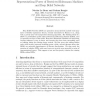Free Online Productivity Tools
i2Speak
i2Symbol
i2OCR
iTex2Img
iWeb2Print
iWeb2Shot
i2Type
iPdf2Split
iPdf2Merge
i2Bopomofo
i2Arabic
i2Style
i2Image
i2PDF
iLatex2Rtf
Sci2ools
117
click to vote
NECO
2008
2008
Representational Power of Restricted Boltzmann Machines and Deep Belief Networks
Deep Belief Networks (DBN) are generative neural network models with many layers of hidden explanatory factors, recently introduced by Hinton et al., along with a greedy layer-wise unsupervised learning algorithm. The building block of a DBN is a probabilistic model called a Restricted Boltzmann Machine (RBM), used to represent one layer of the model. Restricted Boltzmann Machines are interesting because inference is easy in them, and because they have been successfully used as building blocks for training deeper models. We first prove that adding hidden units yields strictly improved modelling power, while a second theorem shows that RBMs are universal approximators of discrete distributions. We then study the question of whether DBNs with more layers are strictly more powerful in terms of representational power. This suggests a new and less greedy criterion for training RBMs within DBNs.
Related Content
| Added | 14 Dec 2010 |
| Updated | 14 Dec 2010 |
| Type | Journal |
| Year | 2008 |
| Where | NECO |
| Authors | Nicolas Le Roux, Yoshua Bengio |
Comments (0)

